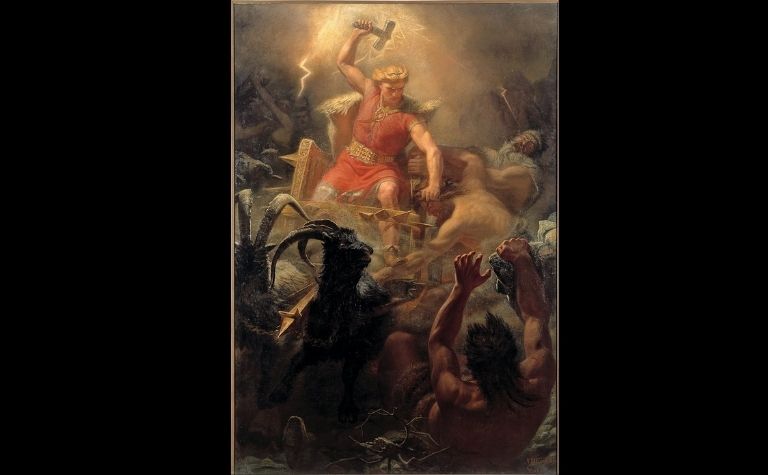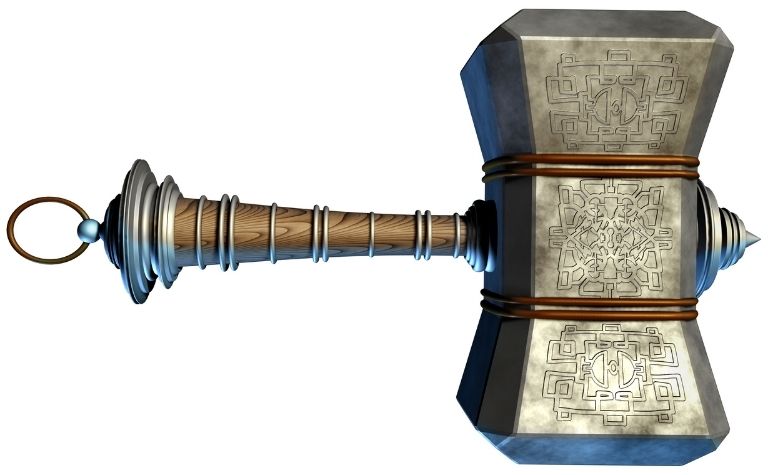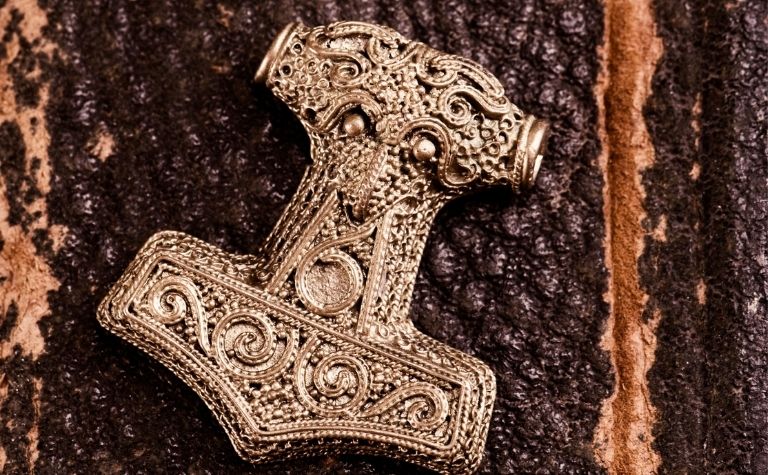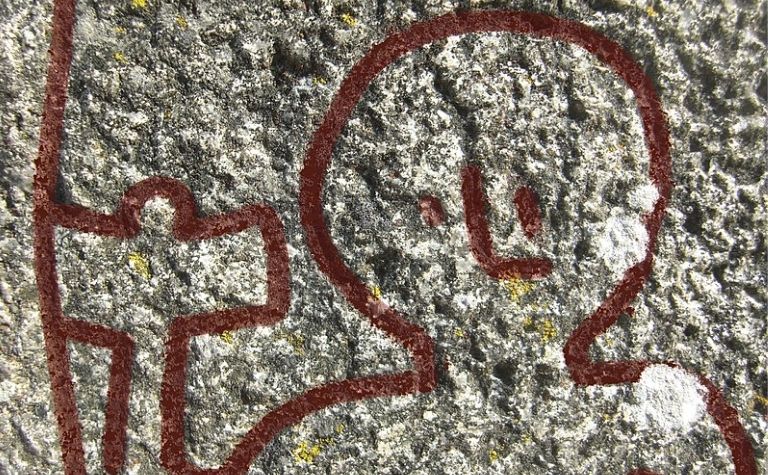The image of Chris Hemsworth as Thor is a familiar one to most people. Even people who haven’t watched the popular Marvel films often recognize him.
However, people who have seen the movies might be surprised to learn that Thor can’t actually fly through the sky when he’s holding his hammer, Mjolnir.
Thor can fly in Norse mythology, but not without help. He can only fly when riding in his chariot, which is pulled by two big, magical goats, Tanngnjóstr and Tanngrisnir.
Thor’s hammer, Mjolnir, is a powerful weapon, particularly against the Jotuns (giants), but it doesn’t grant the power of flight.
This article will dive more deeply into Thor’s hammer, Mjolnir, and what the god can do with it. It’ll also discuss Thor’s goats and chariot, which do allow him to fly.
Also, see Are Thor and Loki Brothers in Norse Mythology? to learn more.

Thor’s hammer doesn’t enable him to fly
In the original Norse myths, Thor’s hammer doesn’t give him the ability to fly. Instead, it allows him to destroy mountains, revive his goats, channel lightning, and kill giants.
It’s also boomerang-like, so if Thor throws it at an enemy, it’ll strike the foe and return to his outstretched hand. [1]
Thor’s hammer, Mjolnir, is indeed the mightiest weapon in Asgard.
The dwarven brothers Brokkr and Sindri (sometimes called Eitri) forged it during a competition with the sons of Ivaldi to see which pair was more skilled at creating things. [2]
In the Marvel comics and movies, one of Mjolnir’s unique attributes is the power of flight. Despite all its power, however, the weapon is flawed.
How Does Thor Soar Through the Sky?
Thor soars through the sky while riding in his chariot, which is pulled by two magical, flying goats, Tanngnjóstr and Tanngrisnir.
When he’s hungry, Thor can also cook and eat the goats. As long as he doesn’t break their bones, he can revive them with Mjolnir the following day.
In one famous myth, Loki and Thor stay the night with a peasant family who doesn’t have much food to share.
Thor roasts his goats and instructs the family to eat what they wish but to preserve the bones.
Loki, ever chaotic, convinces the son, Thjálfi, to crack one of the bones. Despite Thor’s warning, he does, eating the marrow from inside it.
When Thor resurrects his goats the following day, he notices that one of them has a limp.
Enraged that the family didn’t listen to his instructions, Thor grabs his hammer to take revenge. Thjálfi and his family plead for mercy, and Thjálfi offers himself as Thor’s servant.
Thor agrees, taking Thjálfi and his sister, Röskva, as his servants when he leaves.
Also, see Is Thor Immortal In Norse Mythology? to learn more.

What Powers Does Thor Have in Norse Mythology?
According to traditional mythology, the unaltered form of Thor had substantial strength, more so than his father, Odin.
Other than strength, Thor had no special powers. He couldn’t create lightning; he couldn’t fly, and he had no magic powers.
With the help of additional equipment, however, Thor can reach the levels of power that earned him his fame.
Mjolnir – The Hammer of Thor
The weapon most commonly associated with the god of thunder, Mjolnir, was forged by dwarfs and never failed.
This hammer allowed Thor to channel the force of lightning and thunder. [4] Thor and Mjolnir were seemingly inseparable.
Whenever Thor threw the hammer, it always returned to him no matter how far he threw it.
An uncommon power that Mjolnir possessed was the ability to raise the dead. Thor most often used this power to resurrect his two goats, as mentioned earlier.
Jarngreipr – The Gloves of Thor
The Dictionary of Northern Mythology translates Jarngreipr as “iron grippers.” [5] These gloves give Thor the ability to wield his hammer, Mjolnir.
Without these gloves, no one, not even Thor, can wield the hammer.
This is seen in Chapter 20 of Gylfaginning, where it is assumed that the gloves’ necessity is due to the short handle of the hammer.
Megingjord – The Belt of Strength
The literal translation of the word “megingjord” is “power belt.” The belt doubled Thor’s strength whenever he wore it.
With these three pieces of equipment combined, Thor was a feared warrior who could decimate armies without the help of the rest of the Aesir.
Also, see Is Thor Good or Bad in Norse Mythology? to learn more.

Do Marvel Movies Depict Thor’s Powers Accurately?
There are many differences between how Thor is portrayed in traditional Norse texts and the Marvel movies.
The starkest differences between classic Thor and those depicted in the Marvel movies are the way he flies and the ways in which he uses Mjolnir.
There are many errors that Marvel movies make when depicting Thor’s powers. Thor flies using his hammer in the movies.
He hardly flies at all in Norse mythology, but when he does, he uses a chariot. Thor’s appearance is also different in mythology than in the movies.
For example, in the literature and stories, Thor is a red-haired, big bearded man, yet in the movies, he is depicted as blonde-haired and clean-shaven.
The one thing that the Marvel movies got correct is that Thor has a knack for drinking beer.
How Does Thor Fly in the Movies?
In the Marvel movies and the comics, Thor’s favorite flying method involves using the momentum of Mjolnir.
When he spins it fast enough and throws it, he can hold on to it and propel himself over great distances.
While this isn’t the most controlled method of flight, the comics show that he could direct the hammer mid-flight using the power of lightning.
The movies don’t show Thor in flight very often; instead, it shows him taking off and then cuts away.
Flying with a hammer may be the most visually appealing way for Thor to fly on camera; this is not consistent with the historical version of Thor.
There are no instances of Thor using Mjolnir for flight anywhere in the classic texts or poems.
In Thor: Ragnarok, the Marvel Universe version of Thor is actually seen flying without his hammer, relying only on the power within him.
This scene shows a superior version of Thor that only comes out at certain times in the movies and comics, but is certainly inconsistent with the historical understanding of Thor.

The dwarves created Mjolnir to win a wager with Loki
Loki was a clever trickster who always got himself or others into trouble with his schemes.
In one popular Norse myth, he made a wager with the dwarven brothers, Brokkr and Sindri.
He provoked them by telling them that he believed the sons of the dwarf craftsman Ivaldi were the most skilled craftsmen in the land.
When Brokkr and Sindri argued that were better, Loki challenged them, saying that Ivaldi’s sons had made three wonderful gifts for him to present to the gods and that he didn’t think the two of them could craft better ones.
Brokkr and Sindri agreed to Loki’s challenge but set the following terms:
- If the magical items they made weren’t better than those Ivaldi’s sons made, the trickster god could keep all three of them free of charge.
- If their gifts were better, they got to take Loki’s head.
The first gift the brothers made was Gullinbursti, a boar with golden bristles that lit up the night. He was faster than any horse except for Odin’s eight-legged steed, Sleipnir.
Next, they made Draupnir, a golden ring that would drop eight identical golden rings every ninth night.
Finally, they began working on Mjolnir, and Loki knew they would win the wager.
Not eager to lose his head, Loki transformed himself into a fly and bit Brokkr’s eyelid.
Blood ran into the dwarf’s eye, obscuring his vision, and he pulled the hammer out too soon, creating a weapon whose handle was much too short and would have to be swung with a single hand. [3]
That’s why Thor holds the weapon in one hand instead of using the traditional two-handed hammers of the Vikings. He also has to wear special gloves to wield Mjolnir properly.
What Does the Mjolnir Mean to Thor?
In Norse mythology, Mjolnir is symbolic of Thor’s strength, power, and status as Asgard’s staunchest protector against the Jotuns (giants) and all of the Aesir’s other enemies.
It represented safety and peace. As long as Thor had Mjolnir, he would always be able to guard Asgard and its inhabitants.
However, in the Marvel Universe, Mjolnir is a physical representation of Thor’s worthiness to rule. “Worthiness” didn’t enter into the equation.
The idea that Thor alone could lift his hammer because he was the only being worthy to do so is strictly a modern-day Marvel invention.
In the original myths, several other characters lift Mjolnir, including:
- Brokkr and Sindri (or Eitri): The dwarves who made it
- Thrym: A frost giant who stole it
- Magni: Thor’s son
- Modi: Thor’s son*
- Loki: The trickster god of chaos*
*Note: Many of the myths are unclear about whether Modi will wield the hammer after Thor’s death at Ragnarok. Some literary scholars believe that only Magni will use it.
Additionally, some scholars argue that there’s no proof that Loki ever lifted the hammer.
However, Loki presents the gifts to the gods after the dwarves make them, so there’s evidence to support the idea that Loki must have carried it from Svartalvheim to Asgard.
However, just because these other characters could lift and carry the hammer doesn’t mean they could use it.
Thor and his son(s) are the only figures in Norse mythology ever depicted using the hammer as a weapon.
Conclusion
Despite how powerful it is, Mjolnir doesn’t allow Thor to fly. For that ability, he needs a chariot and two large goats.
References:
[1] Source
[2] Source
[3] Source
[4] Source
[5] Source
